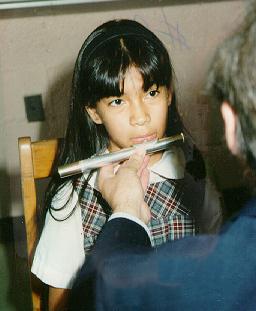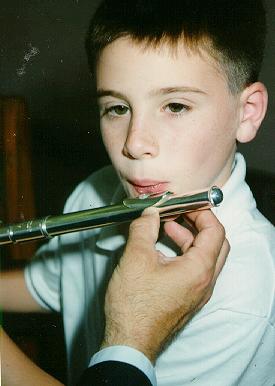TIPS FOR TEACHING BEGINNING FLUTE PLAYERS
October 1996
The follow tips are taken from an article to be published in a future edition of BandWorld Magazine. For subscriptions and more information about BandWorld call 1-800-247-2263.Article by: Dr. Randy Navarre
EMBROCHURE
The flute should not be played like a coke bottle. The student should put their lips together naturally. I tell the students to close their mouth completely, but not tightly. The way you close your mouth when you should be listening to the teacher in class, but instead, you are daydreaming. Have the students blow the air out through the lips. Do not pucker the lips, nor smile. The opening in the lips is a result of blowing the air, not making any special shape. The top lip should not be over the opening of the flute. Just a natural position is the best.
MAKING THE FIRST SOUND
The teacher should place the headjoint up to the student's lip. Instruct them not to blow until you tell them. Center the flute and then tell them when to blow. They should use the syllable pu, not who. This will keep the aperture as small as possible. If the student has a tear drop lip, you may need to move the headjoint into a position that will allow for a better sound. When they make a sound, praise them. It does not need to be a perfect sound. Praise any sound they get. They are scared to death that they will not get a sound, so be encouraging. Have them produce the sound several times without removing the headjoint from their lips, or moving your hands. Then, remove your hands and have them produce the sound again. If they have trouble getting a sound when you move your hands away from the headjoint, with one finger or the thumb, push the mouthpiece against their lips.
THE FIRST WEEK OF PRACTICE
The students should practice the headjoint only for the first week. Even if it is only for ten minutes a day. This will help develop the muscles in the lips, and help to keep the aperture small. Show them how they can get different sounds by putting their finger into the end of the headjoint. I will play Mary Had A Little Lamb by adjusting the depth of my finger into the opening of the headjoint. Then, I will challenge them to try it over the next week. Tell them to practice everyday. If they do not get a sound when they get home, not to worry, just keep trying. They made a good sound at school, and it will happen again. Be positive!HOLDING THE FLUTE PROPERLY
Take the instrument from them. Ask them to hold out their left hand with their palm up. Bend their fingers slightly so you will be able to place the flute in the palm of their hand with the body resting on the knuckle of their first finger. The finger should bend so the flute will rest on the knuckle while the first finger raps around the flute so the first key can be depressed. Adjust their hand position as necessary to help them balance the flute. Place their right thumb under the body between the F & E keys. Adjust the foot so the little finger will comfortably reach the Eb key.THE FIRST NOTES
The first notes the students should play are B, A, G above the staff. Many flutes books start out with F, Eb, D, or D, Eb, C. These are difficult notes to produce a sound, and they are difficult fingerings. Also, these notes will make the students have a much larger aperture. Some beginner books have a pre-first lesson for the flutes with low B, A, G. This is a mistake. It is easy to play high at first. Just tell the students to make it sound high. If they have a problem(and very few will), ask them to play a little louder. They will make it sound high. Later when the low notes appear in the book, the student will have a good tone in the low range.PRAISE THEM, PRAISE THEM, PRAISE THEM
You cannot over praise a student's sound and efforts. Remember, the students are very scared that no sound will come out of the instrument, or it will be a bad sound. If you are expecting a perfect sound or demanding a perfect sound at the first lesson, you will be very disappointed, and you will be extremely discouraging to your students. Any sound they get should be praised. Even if a student does not get a tone on the first lesson, be encouraging. Tell them to keep trying. They will do it if they keep practicing. The students trust you, and they will try very hard for you if you show your enthusiasm for their progress. Sharing your joy of music with them is the real art of teaching. That is when teaching is fun for both student and teacher.





